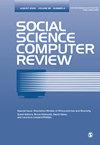Leveraging VLLMs for Visual Clustering: Image-to-Text Mapping Shows Increased Semantic Capabilities and Interpretability
IF 2.7
2区 社会学
Q2 COMPUTER SCIENCE, INTERDISCIPLINARY APPLICATIONS
引用次数: 0
Abstract
As visual content becomes increasingly prominent on social media, automated image categorization is vital for computational social science efforts to identify emerging visual themes and narratives in online debates. However, the methods based on convolutional neural networks (CNNs) currently used in the field are unable to fully capture the connotative meaning of images, and struggle to produce easily interpretable clusters. In response to these challenges, we test an approach that leverages the ability of Vision-and-Large-Language-Models (VLLMs) to generate image descriptions that incorporate connotative interpretations of the input images. In particular, we use a VLLM to generate connotative textual descriptions of a set of images related to climate debate, and cluster the images based on these textual descriptions. In parallel, we cluster the same images using a more traditional approach based on CNNs. In doing so, we compare the connotative semantic validity of clusters generated using VLLMs with those produced using CNNs, and assess their interpretability. The results show that the approach based on VLLMs greatly improves the quality score for connotative clustering. Moreover, VLLM-based approaches, leveraging textual information as a step towards clustering, offer a high level of interpretability of the results.利用vllm进行视觉聚类:图像到文本映射显示了增强的语义能力和可解释性
随着视觉内容在社交媒体上变得越来越突出,自动图像分类对于计算社会科学在识别在线辩论中出现的视觉主题和叙事方面的努力至关重要。然而,目前该领域使用的基于卷积神经网络(cnn)的方法无法完全捕获图像的内涵意义,并且难以产生易于解释的聚类。为了应对这些挑战,我们测试了一种方法,该方法利用视觉和大语言模型(vllm)的能力来生成包含对输入图像的内涵解释的图像描述。特别是,我们使用VLLM生成一组与气候辩论相关的图像的内涵文本描述,并基于这些文本描述对图像进行聚类。同时,我们使用基于cnn的更传统的方法对相同的图像进行聚类。在此过程中,我们比较了使用vllm和使用cnn生成的聚类的内涵语义有效性,并评估了它们的可解释性。结果表明,基于vllm的方法大大提高了隐含聚类的质量分数。此外,基于vllm的方法利用文本信息作为聚类的一个步骤,提供了高水平的结果可解释性。
本文章由计算机程序翻译,如有差异,请以英文原文为准。
求助全文
约1分钟内获得全文
求助全文
来源期刊

Social Science Computer Review
社会科学-计算机:跨学科应用
CiteScore
9.00
自引率
4.90%
发文量
95
审稿时长
>12 weeks
期刊介绍:
Unique Scope Social Science Computer Review is an interdisciplinary journal covering social science instructional and research applications of computing, as well as societal impacts of informational technology. Topics included: artificial intelligence, business, computational social science theory, computer-assisted survey research, computer-based qualitative analysis, computer simulation, economic modeling, electronic modeling, electronic publishing, geographic information systems, instrumentation and research tools, public administration, social impacts of computing and telecommunications, software evaluation, world-wide web resources for social scientists. Interdisciplinary Nature Because the Uses and impacts of computing are interdisciplinary, so is Social Science Computer Review. The journal is of direct relevance to scholars and scientists in a wide variety of disciplines. In its pages you''ll find work in the following areas: sociology, anthropology, political science, economics, psychology, computer literacy, computer applications, and methodology.
 求助内容:
求助内容: 应助结果提醒方式:
应助结果提醒方式:


